Peter II of Yugoslavia
| Peter II | |
|---|---|
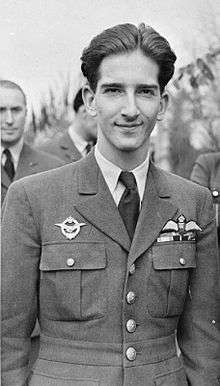 King Peter in January 1944 | |
| King of Yugoslavia | |
| Reign | 9 October 1934 – 29 November 1945 |
| Regency ended | 27 March 1941 |
| Predecessor | Alexander I |
| Successor |
Monarchy abolished (Ivan Ribar as President of the Presidency of the People's Assembly of Yugoslavia) |
| Regent | Paul (1934–41) |
| Born |
6 September 1923 Belgrade, Yugoslavia |
| Died |
3 November 1970 (aged 47) Denver, Colorado, U.S. |
| Burial |
Saint Sava Monastery, Libertyville, Illinois (1970–2013) St. George's Church, Oplenac, Serbia (since 2013) |
| Spouse | Alexandra of Greece |
| Issue | Alexander, Crown Prince of Yugoslavia |
| House | Karađorđević |
| Father | Alexander I of Yugoslavia |
| Mother | Maria of Romania |
| Religion | Eastern Orthodox |
| Styles of Peter II of Yugoslavia | |
|---|---|
 | |
| Reference style | His Majesty |
| Spoken style | Your Majesty |
| Alternative style | Sir |
Peter II (Serbo-Croatian: Petar/Петар; 6 September 1923 – 3 November 1970) was the last King of Yugoslavia, and the last reigning member of the Karađorđević dynasty which came to prominence in the early 19th century.
Peter II was the eldest son of Alexander I and Maria of Romania; his godfather was British king George V of the United Kingdom
Early life
Prince Peter was initially tutored at the Royal Palace, Belgrade, before attending Sandroyd School in Wiltshire, England. When he was 11 years old, Prince Peter succeeded to the Yugoslav throne in 1934 upon the assassination of his father King Alexander I in Marseille during a state visit to France. In view of the new monarch's young age, a regency was set up under his father's cousin Prince Paul.
World War II
Although King Peter II and his advisors were utterly opposed to Nazi Germany, Regent-Prince Paul declared that the kingdom of Yugoslavia would join the Tripartite Pact on 25 March 1941. Two days later, King Peter, at age 17, was proclaimed of age, after a British-supported coup d'état.
Postponing Operation Barbarossa, Germany simultaneously attacked Yugoslavia and Greece on 6 April 1941. Within a week, Germany, Bulgaria, Hungary and Italy invaded Yugoslavia, and the government was forced to surrender on 17 April. Parts of Yugoslavia were annexed by Italy, Bulgaria, Hungary and Germany. The remaining parts of the kingdom of Yugoslavia, Croatia and Serbia, two Nazi-puppet governments were installed.
Peter left the country with the Royal Yugoslav Government's ministers following the Axis invasion;[1] initially the Yugoslav king and his government ministers went to Greece en route to British-ruled Jerusalem in Palestine, and then Cairo in Egypt. In June 1941, King Peter arrived in London where he joined numerous other governments in exile from Nazi-occupied Europe.[2]
The King completed his education at Cambridge University before being commissioned in the Royal Air Force. In 1942 he made an ambassadorial visit to America and Canada, where he met American President Franklin D. Roosevelt and Canadian Prime Minister William Lyon Mackenzie King. The whirlwind tour was unsuccessful in securing Allied support for the exiled Yugoslav monarchist cause. FDR and Churchill had already engaged the support of the Communist Yugoslav Government in the Allied effort to defeat Nazi Germany, with a view to ending the hostilities.
Marriage
Peter married his third cousin, Princess Alexandra of Greece and Denmark in London on 20 March 1944. They had one son, Crown Prince Alexander, who was born on 17 July 1945.
Peter filed for divorce in 1953.[3] He hired attorney René de Chambrun, the son-in-law of Vichy France Prime Minister Pierre Laval.[3] However, the couple reconciled in 1955.[4]
Deposition and exile
Though the war ended, Peter was not allowed to return home. He was deposed by Yugoslavia's Communist Constituent Assembly on 29 November 1945. After that, he settled in the United States. After many years of suffering from cirrhosis of the liver,[5] he died in Denver, Colorado, on 3 November 1970, after a failed liver transplant.
He was interred in Saint Sava Monastery Church at Libertyville, Illinois, the only European monarch so far to have been buried in America.[6][7]
Return of remains and state funeral
On 4 March 2007, former Crown Prince Alexander announced plans to have his father's remains repatriated to Serbia. The plan upset some Serbian-Americans. Peter II had chosen St. Sava Serbian Orthodox Monastery as his interim resting place because of the extenuating circumstances that afflicted his homeland.[8] After talks with the Serbian government, the move was confirmed in January 2013 with the burial place being the Royal Family Mausoleum in Oplenac.[9]
On 22 January 2013, Peter's remains were returned to Belgrade, Serbia.[10] He lay in state in the Royal Chapel in Dedinje before being buried in the Royal Family Mausoleum at Oplenac on 26 May 2013 along with his wife, Queen Alexandra. His mother, Queen Marie, and his brother, Prince Andrej, lie nearby. The Serbian Royal Regalia were placed over Peter's coffin. Present at the return ceremony were the Prime Minister Ivica Dačić, Peter's son Alexander with his family, and Serbian Patriarch Irinej.[2][11] The latter openly advocated for the restoration of the Serbian monarchy.[12]
Gallery
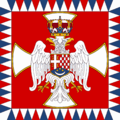 Royal Standard of the King of Yugoslavia
Royal Standard of the King of Yugoslavia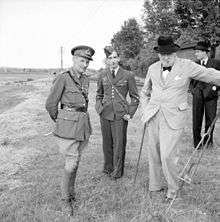 General Montgomery (left), King Peter II (center), and Churchill (right) in July 1941
General Montgomery (left), King Peter II (center), and Churchill (right) in July 1941
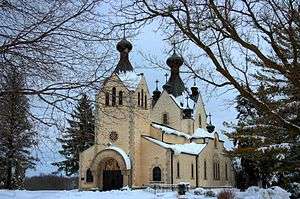 Saint Sava Monastery Church, Illinois, King Peter II's initial burial place (for four decades)
Saint Sava Monastery Church, Illinois, King Peter II's initial burial place (for four decades)
_Serbien.jpg) St George's Church, Oplenac, resting place of King Peter II's remains
St George's Church, Oplenac, resting place of King Peter II's remains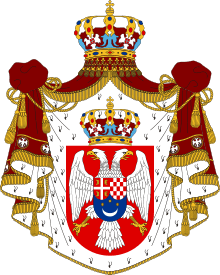 Royal coat of arms of Peter II of Yugoslavia
Royal coat of arms of Peter II of Yugoslavia
Titles, styles, honours and arms
Titles and styles
- 6 September 1923 – 9 October 1934: His Royal Highness The Crown Prince of Yugoslavia
- 9 October 1934 – 29 November 1945: His Majesty The King of Yugoslavia
- in pretense: 29 November 1945 – 3 November 1970: His Majesty King Peter II of Yugoslavia
Honours
| Kingdom of Yugoslavia | |
| Order of St. Prince Lazar, Sovereign and Collar | |
| Order of Karađorđe's Star, Grand Master and Grand Cross | |
| Order of Karađorđe's Star with Swords, Grand Master | |
| Order of the White Eagle, Grand Master and Grand Cross | |
| Order of the White Eagle with Swords, Grand Master | |
| Order of the Yugoslav Crown, Grand Master and Grand Cross | |
| Order of St. Sava, Grand Master and Grand Cross | |
| International and Foreign Awards | |
| Légion d'honneur, Grand Cross (France) | |
| Order of the Redeemer, Grand Cross (Greece) | |
| Order of the Most Holy Annunciation, Collar (Italy) | |
| Order of Saints Maurice and Lazarus, Bailiff Grand Cross (Italy) | |
| Order of the Crown of Italy, Knight Grand Cross (Italy) | |
| Constantinian Order of Saint George, Bailiff Grand Cross (Two Sicilies) | |
| Order of Saint-Charles, Knight Grand Cross (Monaco) | |
| Order of Malta, Bailiff Grand Cross (SMOM) | |
| Order pro merito Melitensi, Collar (SMOM) | |
Ancestry
| Ancestors of Peter II of Yugoslavia |
|---|
|
|
Bibliography
- Petar: A King's Heritage; The Memoirs of King Peter II of Yugoslavia; London: Cassell, 1955.
References
- ↑ Yugoslavia's exiled Queen returns home at long last
- 1 2 "Remains of last Yugoslav king Peter II Karadjordjevic returned from US to Serbia". The Washington Post. washingtonpost.com. Associated Press. 22 January 2013. Retrieved 23 January 2013.
- 1 2 "Ex-King To Get Divorce". The Plain Speaker. September 11, 1953. Retrieved August 2, 2016 – via Newspapers.com. (registration required (help)).
- ↑ Moser, Whet (January 24, 2013). "The Sad Life of Peter II, and the Curious Disinterring of the King of Yugoslavia From Libertyville". Chicago Magazine. Retrieved August 2, 2016.
- ↑ Overy, Richard (2010). The Second World War: The Complete Illustrated History. Carlton Books. ISBN 978-1-84732-451-1.
- ↑ http://photoblog.nbcnews.com/_news/2013/01/23/16664297-only-european-king-buried-on-us-soil-goes-back-home?lite
- ↑ http://serbamericanhistoryfilm.com/king-petar-of-yugoslavia/
- ↑ Tarm, Michael (4 March 2007). "King's body in U.S. may head to homeland". The Boston Globe. boston.com. Associated Press. Retrieved 23 January 2013.
- ↑ "HM King Peter II Returns Home after 72 Years". Balkans.com Business News. Balkans.com. 20 January 2013. Retrieved 23 January 2013.
- ↑ "King Peter II Now in Royal Palace Chapel". Royal Family of Serbia.
- ↑ "The remains of King Peter II in Belgrade (Посмртни остаци краља Петра II у Београду)". Radio Television of Serbia (in Serbian). rtv.rs. Tanjug. 22 January 2013. Retrieved 23 January 2013.
- ↑ Serbian Patriarch Irinej states that Serbia needs emperor or king, or some form of parliamentary monarchy. Retrieved 23 January 2013.
External links
| Wikimedia Commons has media related to Peter II of Yugoslavia. |
| Peter II of Yugoslavia Born: 6 September 1923 Died: 3 November 1970 | ||
| Regnal titles | ||
|---|---|---|
| Preceded by Aleksandar I |
King of Yugoslavia 9 October 1934 – 29 November 1945 |
Monarchy abolished |
| Titles in pretence | ||
| Loss of title |
— TITULAR — King of Yugoslavia 29 November 1945 – 3 November 1970 |
Succeeded by Crown Prince Alexander |